A Theory of Environmental Change Based on Inclusive Partnerships
One million Californians don’t have access to clean drinking water. A surprising ingredient has been part of the problem: cow manure. An award-winning partnership convened by Sustainable Conservation offers a solution that transforms this pollutant into a valuable resource to protect our aquifers and the communities who depend on them.
THE CHALLENGE
California’s nearly two million dairy cows produce over 20% of the nation’s milk – more than any other state. With that many cows comes a mountain of manure, which can pollute groundwater if not managed properly. Many farming communities rely on aquifers for their drinking water. This proximity breeds peril – but also possibility.
Farmers are natural caretakers of the soil, water, and air on which their livelihoods depend. Their jobs require daily creativity to contend with myriad challenges, including periods of profound drought that regularly distress our Golden State. If California is going to continue to feed the nation, we need to co-create conservation solutions with the people who grow our food.
From the corn field to the Capitol, Sustainable Conservation elevates promising technologies and builds support networks around farmers so environmental innovation takes root where it’s needed most. For over 25 years, we have built a theory of change on the bedrock of inclusive partnerships. Finding common ground with one another offers the best chance we have to secure healthy water and air for all Californians.
Unlocking that potential often starts with a single conversation.
THE FARMER
2014 was among the driest years in California history. Nate Ray, CEO of De Jager Dairy in Chowchilla, was seeking solutions. In Nate’s part of the San Joaquin Valley, state-allocated water deliveries had dried up completely – as had many wells that draw upon aquifers, subterranean water stores that act as California’s emergency supply during dry times.
To save water, De Jager Dairy was in the midst of transitioning to drip irrigation. Instead of flooding fields to hydrate crops, rubber tubing buried close to plant roots would now deliver water and nutrients more precisely to the corn and wheat that feed the dairy’s cows. Like all dairy farmers, manure was also, always, on Nate’s mind – to the tune of 120 pounds of waste per cow per day. Could the dairy solve for water supply and water quality in tandem?
For advice, he knew just who to call. “We contacted Sustainable Conservation because we’d worked with them to implement on-farm solutions before. They’re a trusted partner,” said Nate.
Our quartet of dairy experts – Ladi Asgill, John Cardoza, Eric Lee, and Ryan Flaherty – answered, and the group got to work on a fresh collaboration.

Tune in for some good news from Sustainable Conservation Senior Project Manager John Cardoza on episode 3 of Western United Dairies’ “Seen & Herd” podcast.
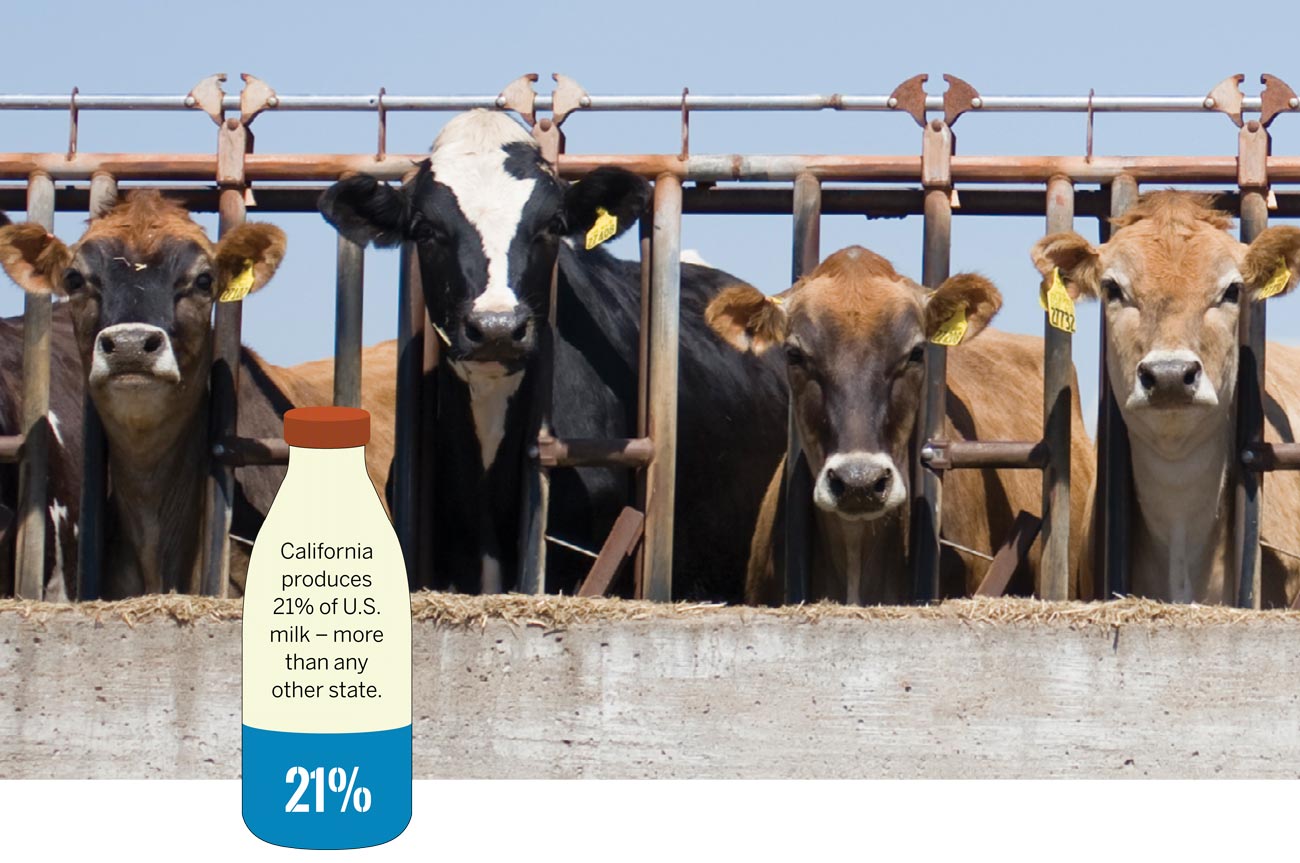
THE TECHNOLOGY
Using dairy manure to fertilize feed crops isn’t a new idea, but running it in liquid form through irrigation tubing – instead of applying it directly to fields – is. Enter Netafim, one of the world’s leading irrigation companies. Founded in the Negev desert in Israel, Netafim brings a deep understanding of farming in extreme conditions.
Our dream team convened, we installed a pilot project at De Jager Dairy to test the potential for saving water, protecting water quality, and reducing fertilizer costs – all while maintaining crop yields.
What we affectionately nicknamed the Frankenstein prototype – consisting of an above-ground filtration station and a below-ground irrigation network – was painstakingly tended by engineering genius and Netafim USA consultant Dennis Hannaford. Over 2 ½ years, Nate, Dennis, and Sustainable Conservation staff worked out the kinks in the system, and cross-referenced results with flood-irrigated control fields through water, soil, and crop tissue samples.
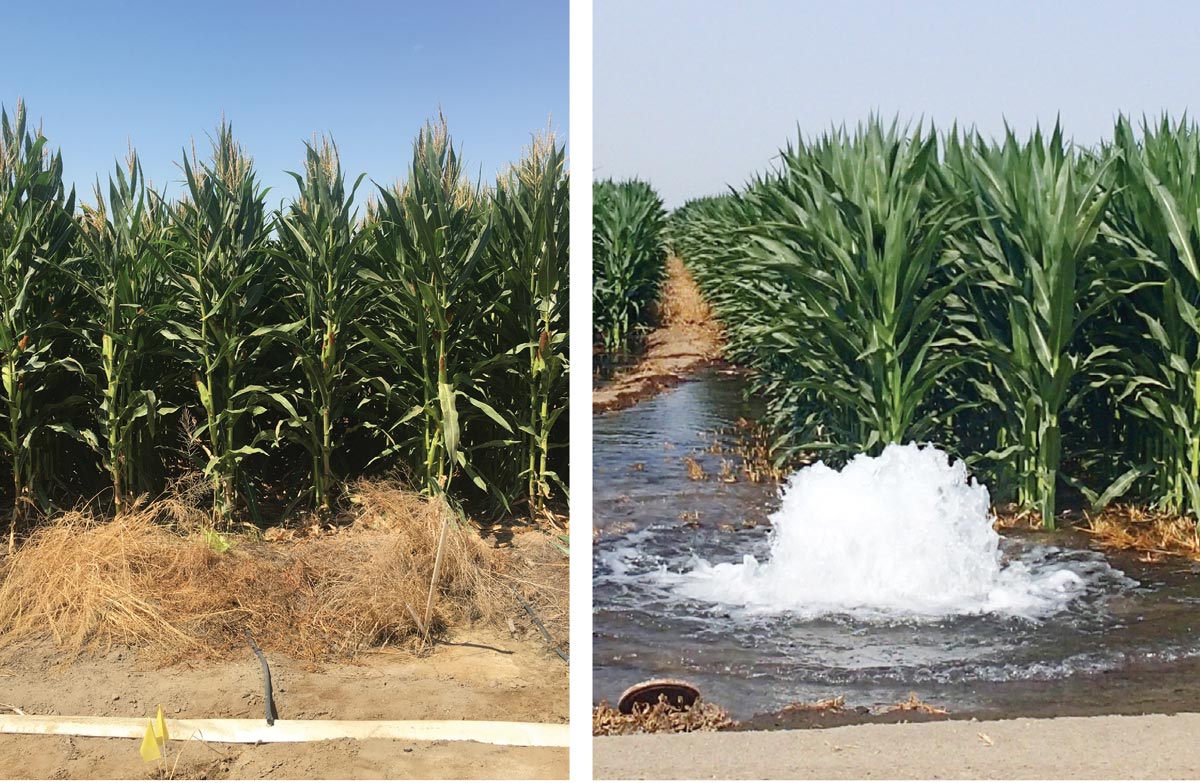
Visible water savings: our pioneering system, which precisely applies water and manure fertilizer via drip irrigation (left), vs. flood irrigation (right). Our system supports healthy aquifers by helping dairy farmers make the best use of limited water supplies and the “black gold” their cows already produce to grow feed crops.
“As we move our sustainability efforts from sustaining resources to regenerating them, innovations like Sustainable Conservation and Netafim USA’s subsurface drip irrigation management tool have been critical as we seek to manage water resources and food production. It is imperative that we identify solutions for those who can make some of the biggest regenerative impacts: the farmer.”
– Mary Jane Melendez, General Mills Chief Sustainability and Social Impact Officer
THE PARTNERSHIP
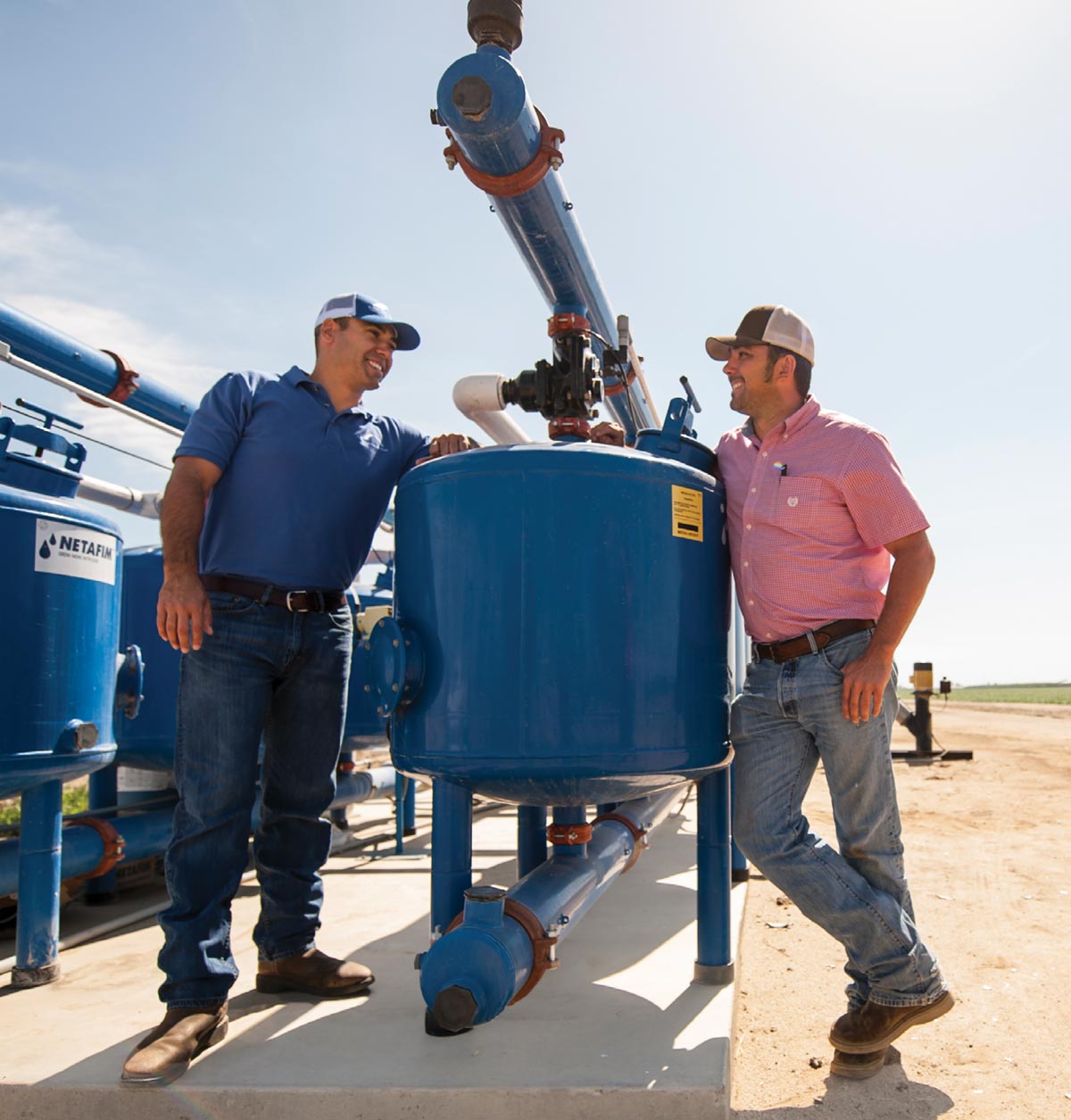
Sustainable Conservation Senior Project Manager John Cardoza (left) and De Jager Dairy CEO Nate Ray.
What we learned was promising enough to land the team a competitive U.S. Department of Agriculture Natural Resources Conservation Service (NRCS) Conservation Innovation Grant in 2016 to scale to three San Joaquin Valley dairies of varying sizes and management practices – with university, private lab, and industry partners on board to demonstrate and promote the system.
Together, we refined and proved a new technology that transforms dairy waste from a potential pollutant to a valuable resource while reducing nitrate contamination of groundwater and improving air quality.
The system allows the same, or more, corn to be grown with approximately 36% less water, 45% less nitrogen, and 70% fewer irrigation-related greenhouse gas emissions as compared to traditional flood irrigation. Lowering demand on water means less stress on severely depleted aquifers and more water available for wildlife habitat, including in-stream flows for fish.
On the 50th anniversary of Earth Day this past April, our project team (Sustainable Conservation, Netafim USA, Western United Dairies, De Jager Dairy, and Michael McRee Dairy) was honored with the 2020 U.S. Dairy Sustainability Award for Outstanding Community Impact. The award, given by the Innovation Center for U.S. Dairy, celebrates innovative partnerships between businesses and dairy farms whose impacts balance economically viable, socially responsible, and environmentally sound stewardship practices.

Sustainable Conservation’s theory of environmental change
- Partner to pilot a new practice, technology, or approach.
- Evaluate the potential impact if scaled.
- Identify barriers to adoption, and develop tools and incentives to assist with scaling.
- Leverage drivers for change (e.g., policy like California’s Sustainable Groundwater Management Act).
- Expand collaboration to wider group of partners to support scaling.
THE INCENTIVE
Based on proof of the system’s environmental and agricultural benefits delivered by our partnership, the U.S. Department of Agriculture Natural Resources Conservation Service (NRCS) is now providing nationwide cost-share funding through the Environmental Quality Incentives Program (EQIP). In California, EQIP currently covers up to 80% of installation costs for dairy producers interested in adopting the technology.
That’s especially good news right now, when the effects of COVID-19 are likely to hasten the consolidation of California dairies. Dairies who want to stay in the Golden State will need to invest in practices and technologies that care for environmental and business health in tandem.
Sustainable Conservation and Netafim USA are continuing industry outreach, with an additional 19 dairies in the works to install systems this year. Netafim USA is also exploring national scaling, including moving beyond dairies to hog farms and food processing plants.
THE FUTURE
In our drought-prone Golden State, depleted and polluted aquifers threaten the communities who grow the food that nourishes us all. Technologies that help farmers save water and protect water quality are vital – especially as California plans for long-term groundwater sustainability.
Lasting environmental change really only comes from listening to the people who work on the ground, and incorporating their needs and ideas into solutions. By uniting our voices, we can take good care of the planet and people.
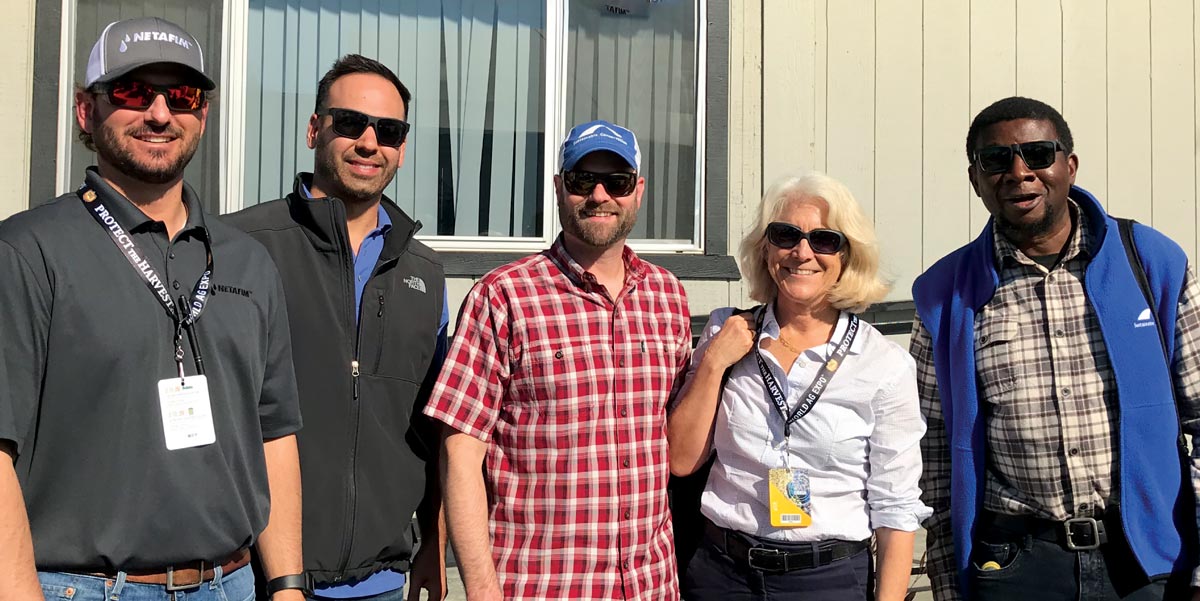
Sustainable Conservation and Netafim USA at the 2020 World Ag Expo.
“Despite facing many pressures, California farmers are resilient and always look for ways to lead in environmental stewardship. Sustainable Conservation crafts practical technology and solutions in lockstep with farmers and industry partners that lead to enduring environmental solutions. This new drip system helps California dairies produce healthy milk while reducing their water and greenhouse gas impacts, and serves as a model for dairy producers across the U.S.”
– Karen Ross, Secretary of the California Department of Food and Agriculture

